Comrade Mauser - man and rifle
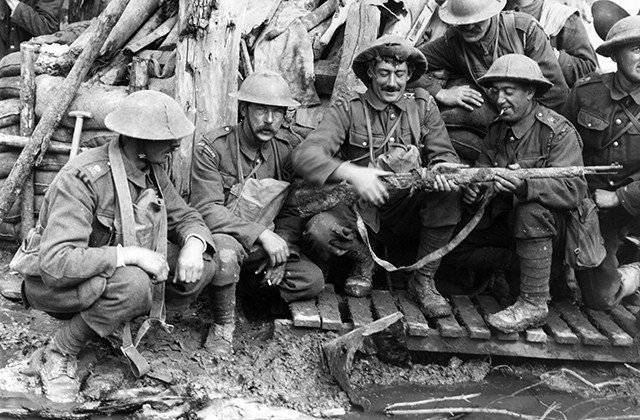
History creation and service of the most massive small weapons Great War
The Mauser 98 rifle occupies a special place in the military-technical history of not only the Great War, but also of the whole XX century, becoming one of the symbols of the ideal infantry infantry weapon. It was created by the outstanding German designer Paul Mauser in collaboration with his elder brother Wilhelm at the end of the previous century, but for almost half a century after that was in service with the armies of not only Germany of both Reichs, but also several dozen countries, including Russia, as tsarist so and Soviet. A variety of civilian modifications Mauser 98 and now enjoy great success. According to the most modest estimates, a total of several tens of millions of these rifles were made in different versions and under different names.
In the world, of course, rifles were created, which in some aspects can be considered more successful than the "Mauser". For example, the Japanese Arisaka Type 38 infantry rifle had the best balance, and the Russian famous three-line Mosin rifle was structurally much simpler than the Mauser. However, the success of the weapon as a whole is always determined by the combination of technical and operational properties, and for most of them Mauser 98, if suddenly, was inferior to others, very little.
Thirteenth child
The fate of Paul Mauser, the youngest of 13 children of the gunsmith Franz Andreas Mauser, captures the whole epoch of Germany’s magical heyday at the turn of the nineteenth and twentieth centuries. Paul was born 27 on June 1838, and 29 died on May 1914, and therefore it was possible to live in the most brilliant and best, undoubtedly, period of the ethnopolitical life of the German people. As a young 33-year-old man, he enthusiastically met the German triumph of the French-Prussian 1870-1871 war, and died without seeing, fortunately, what kind of monstrous ruins turned Germany's land, culture and even morality. World War I.
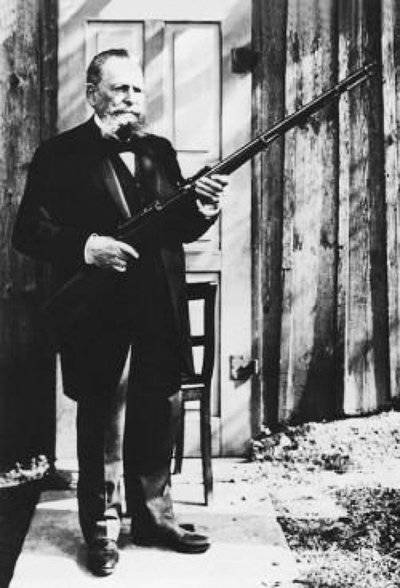
The life of Paul Mauser is almost an exact cast (adjusted for his natural technical genius) from the fate of hundreds of thousands of artisans Germans who created the honorable glory of the European industrial workshop in Germany. From the 12 years, he began to help his father and his four older brothers at the workbench in an armory factory in the walls of the old August monastery in Oberndorf. His work was so good that, since 14 years, Paul began to pay for completed orders as an adult artisan.
After being drafted into the army, Paul was fortunate enough to serve as an artillery mechanic in the large Ludwigsburg arsenal. Here, the 23-year-old gunsmith was able to compare the most advanced rifle and artillery systems of the time, to understand the specifics of the military requirements for the use of weapons in combat conditions. In Ludwigsburg, Paul Mauser first tried his hand in the design field: according to his drawings, a field breech-loading cannon was made, which has survived to the present day and is now on display at the Weapon Museum in Stuttgart.
When the army service ended, Paul Mauser returned to his native Oberndorf. During his absence, the Mauser armory became significantly weaker: Paul’s father died, the elder brothers Josef and Heinrich actually left the family business, another brother, Franz, emigrated to America and began working as a master at the Remington arms firm.
First success
The family business could only be saved by a truly breakthrough, innovative project in the field of military weapons. The leading European powers were on the verge of re-equipping their armies with a new type of infantry rifle for a unitary metal cartridge.
Having comprehended the most promising trends in the design of infantry weapons, Paul Mauser came to the conclusion that only one technical idea guarantees the future of a future rifle: a rotary when locking the barrel, a powerful bolt. The reliability of the action of this shutter was provided by a twisted combat spring hidden in its stem.
The timely help of Brother Wilhelm, as well as the financial support of Remington’s representative in Germany, S. Norris, allowed Paul Mauser to go to Belgium for an internship, for the best weapons factory in Europe at that time in Liege. The result of this trip was the receipt of a patent for the original "Mauzer" technical solutions. On their basis, in the period from 1867 to 1869, a promising single-shot rifle of the caliber 11 mm, known in weapon science as the Mauser-Norris MXNXX / 67 model, was created.
The results of the complex tests of the new rifle by the Prussian Royal Arms Commission in Spandau led to the first impressive success of the Mauser design firm. The new infantry rifle under the metal unitary cartridge caliber 11 mm was officially adopted by the united German army under the heading "Mauser M.71". The Royal Arms Commission demanded, however, to make in the design of the weapon some changes that enhance the reliability.
As the gunsmith scientist V.Hristich notes in his essay about the Mauser rifle, the criticism and recommendations of the commission in Spandau affected mainly the safety device. In February, the 1872 of the year, when mass production of the Mauser M.71 rifle began, the fuse was fundamentally modified - in fact, this resulted in a change in the technical configuration of the entire shutter. At the back of the stem of the bolt, a reliable flag switch was placed - when turning to 180˚, he firmly locked the drummer with his whisk, preventing the shooter from firing or opening the bolt. This fuse design turned out to be so successful that it has since become a feature of all later Paul Mauser rifles.
The production of the M.71 rifle began with a large order provided by the Prussia military department. The firm of the Mauser brothers in Oberndorf began to experience a real flourishing: by the end of the summer 1872 had more than 100 workers in the factory floor. Two new steam engines were installed here. In September, 1872, the first batch of Mauser M.71 rifles, was solemnly armed with the fuseler battalion of the 1 regiment of the Prussian Guard.
The Prussian order served as the foundation for the formation of the Brothers Mauser & Co. arms concern. For each M.71 rifle, which Prussia and Bavaria began to massively manufacture at factories in Westphalia, Erfurt, Danzig, Spandau, Suhl and Berlin, a copyright fee was received by the Mauser company. Large weapon orders were also placed abroad: 200 thousand were manufactured in Birmingham, and 240 thousand rifles were made at the Austrian factory in Steyr. In 1876, the Mauser brothers completed an order for 26 thousands of rifles for China.
Mauser walks on the planet
The next step in the design ascent to the classic rifle archetype “Mauser 98” was the creation of the model “Mauser M.88” for the army of Belgium.
In the second half of the nineteenth century, among the military experts of the leading states of Western Europe, a discussion flared up about the prospects of re-equipping European armies with multiply charged shop-rifle systems. The impetus for this discussion was the successful experience of the use of Spencer and Winchester shop-karabiners during the American Civil War (1862-1865 years). Opponents of the rearmament of the European armies for multiply-charged systems made essentially only one, but very weighty argument: a multiply charged rifle in the hands of an inexperienced soldier would become a tool for meaningless squandering of expensive unitary cartridges. An unnecessarily fast, erratic, and therefore unarguable firing, pointed out by opponents of "recharging", will lead to a colossal ineffective waste of ammunition, but will not provide increased infantry combat power.
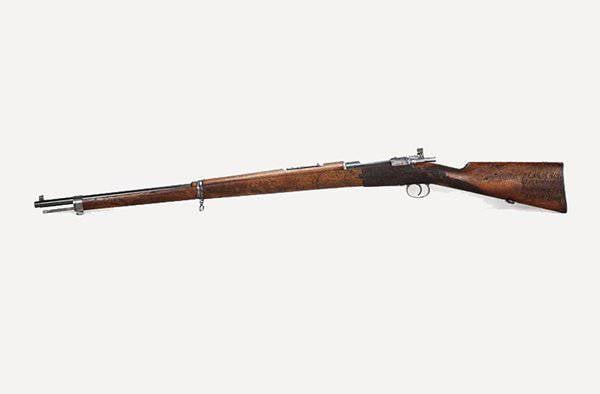
The line under this discussion in the general headquarters of Europe, strangely enough, little Switzerland summed up by adopting the 27 in February 1868 of the year F. XVUMX-charging rifle of the F.Vetterly system with the 13-20 sighting rate per minute. A year later, Austria-Hungary followed the example of Switzerland, adopting the 25-charging carbine of the F.Fruvirth system into gendarmerie and border troops. A few years later, France began to equip its infantry formations with multiple recharges, where the Gra-Kropachek 8-charging rifle was adopted.
Strengthening the firepower of the land army of its main enemy in Europe was assessed accordingly in the German General Staff. From January 1879, a special commission of the Prussian rifle school in Spandau under the command of General G. von Schwarzgoff began comparative tests of multiply charged rifle systems for the development of technical and operational parameters for a promising German magazine rifle.
In September, 1881, the Brothers Mauser and Co. firm offered its new multiply-charged model based on the already-used Mauser M.71. Kaiser Wilhelm I himself became interested in the new model of the rifle, and as a result, troop tests and rifle refinement were accelerated. As soon as the 2-thousandth experimental batch of the new product of the Mauser brothers successfully passed field trials in the army, the new rifle was adopted by Germany with the official stamp: "71 / 84 infantry magazine rifle 11 mm."
Wilhelm Mauser could not enjoy this wonderful event with his brother. From June 1879 of the year to February 1881, he “punched” another weapon order in Serbia. In the end, the contract with Belgrade for the supply of 100 thousand Mauser M.71 rifles for 6 million francs was signed, but this contract was the last one for the older brother. In Serbia, Wilhelm Mauser caught a bad cold, then a whole year was sick with a strange fever and died on September 13 of the year 1882.
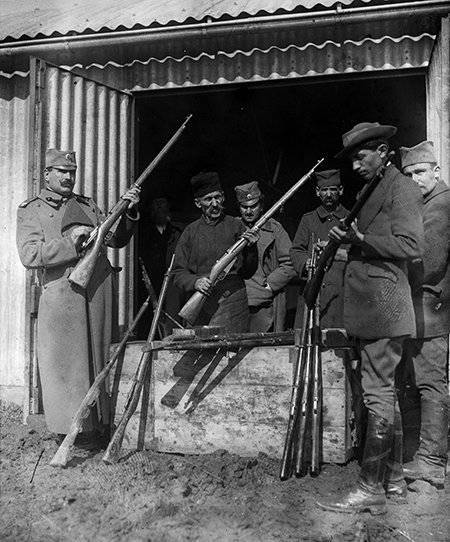
The Serbian army highly appreciated the fighting qualities of the Mauser M.71 rifle. In the spring of Belgrade, 1884 was followed by a new order for another 8 000 rifles - now in the shop version M.71 / 84. In addition to this delivery, another 19 of thousands of "Mauser" ordered the kingdom of Württemberg.
The M.71 / 84 rifle gradually gained a reputation as an "unkillable" infantry rifle. In February 1887 of the year, the Brothers Mauzer and Co. firm signed the largest contract with Turkey. The Ottoman Empire, which had suffered a heavy defeat in the war with Russia on the eve, did not bother to stuff: the Turks ordered 550 thousands of rifles and 5 thousands of carbines based on the M.71 / 84 model (the so-called “Turkish Mauser M.87”).
For each rifle, Paul Mauser set a fairly high price - 68 pfennigs 80, hoping for the money received to quickly deploy additional production capacity. However, it was impossible to digest the huge Turkish order to the firm of Mauser with its own forces. I had to "share" part of the order with the military concern "Ludwig Leve". However, cooperation with the company L. Leve ultimately benefited everyone: the factory capacity of the subcontractor allowed P. Mauser to master the German military order to manufacture 425 thousands of rifles of the new M.XNX model.
"Pachechnaya" rifle "Mauser and Commission"
The new model of Paul Mauser, known under the official name of “German infantry rifle M.88”, was distinguished by considerable originality. The rifle had some special features: two powerful warheads in the front of the bolt, a rotating ejector of spent cartridges, a thin steel casing around the barrel, which protected the fingers of the gunner from burns during intensive shooting. However, the most remarkable feature of this model was the so-called “burst” loading, which allows to dramatically speed up the process of recharging and, accordingly, the rate of fire.
A trapezoid pack, stamped from thin sheet steel, in which, like in a cage, there were 5 cartridges, was inserted into the top of the magazine box and held there by a special latch. A special spring-loaded feeder each time the shutter was opened, put another cartridge on the dismounting line in the barrel. After all the cartridges were used up, the empty pack either fell into the lower opening of the magazine box itself, or was pushed out of it by a new equipped pack.
This reloading system, first proposed by Austrian gunsmith Ferdinand von Mannlicher, caused a certain confusion in the literature of the armory. The brainchild of Paul Mauser was called the system “Mauser-Mannlicher”, and sometimes simply “Mannlicher”. Ultimately, the name “Mauser and Commission system” was finally established in Germany itself. The word "Commission" in the official name of the new rifle was used in recognition of the large contribution of the Armory Commission in the infantry control of the German General Staff in equipping P. Mauser's rifle with a new 7,91 mm caliber cartridge with smokeless powder.
The 7,91 mm cartridge, proposed by the Armory Commission, had excellent ballistic qualities: smokeless powder, developing pressure in the barrel near 3 000 atmospheres, reported the initial velocity to the bullet in 600-650 m / s (for comparison: the same bullet could fly with the smoke powder with speed no higher than 400 m / s).
The new Mauser M.88 rifle caused a significant response in the military departments of many countries. The firm of Paul Mauser received an order for the main infantry rifle for the Belgian army (the Belgian Mauser M.89). At the same time, in cooperation with the Ludwig Leve enterprise, the orders of Argentina (Argentine Mauser M.91), Spain, Ecuador, Colombia and Bolivia were carried out. Without any exaggeration, it can be argued that the Mauser rifle in most countries of Latin America at the end of the nineteenth century was out of competition, despite the proximity of the powerful US weapons industry with its abundance of the most modern systems.
On the eve of the Great War
Starting with the Spanish version of the Mauser carbine, a valuable improvement was introduced into the design. Paul Mauser forever abandoned the “pack” recharge system in favor of a simple, very reliable shop with a chess arrangement of cartridges. The special security of this store was given by its location - completely recessed in the rifle box.
The cartridges from the store rose upwards with a wide lamellar spring and, thanks to a chess arrangement, to the left, then to the right, alternately fed the bolt into the barrel.
In total, by the 1896, the Spanish army received from Germany 251 800 rifles and 27 500 carbines of the model M.93. Around the same time, the “Spanish” model of the “Mauser” adopted China, Paraguay, and Chile with almost no changes.
In 1895, Paul Mauser demonstrated the “Spanish” version of the rifle to the Sultan of the Ottoman Empire. The reaction of the Turks followed immediately: the previous order for Mauser M. 90, according to which the Turkish army had already received 280 thousands of rifles, was reoriented to a new system with an increase in supply from 550 thousands to 700 trunks.
A year before the beginning of the twentieth century, the rifle of Paul Mauser “tested” on a large scale on the battlefields of the Spanish-American and Anglo-Boer wars. The opinion of all the participants in the battles was the same: the Mauser rifle as an infantry military weapon was excellent. The leader of the Boer national-liberation movement, General Ben-Vilzhen, noted: "The Mauser rifle is very carefully designed, it is the best - as a combat rifle and as a rifle for firing at the target."
In 1896, after intensive field testing, a rifle under the heading M.96 was adopted by the Swedish army. The first deliveries to Stockholm were provided by the Mauser firm, and later the production of the M. 96 for the new unguided 6,5 mm cartridge was established under license from the royal arms factory Karl Gustav in Elkilstuna, which produced this weapon up to the 1944 year. Almost simultaneously with Sweden, the model M.96 was put into service with Brazil, Mexico, Cuba, Bolivia, Paraguay, Peru, El Salvador, Uruguay, Chile. In Africa, Mauser M.96 entered infantry formations of the Transvaal, Congo and Orange Republic.
In preparation for a global military conflict, the German Empire commissioned the firm of Paul Mauser to prepare for mass production a technologically improved version of a rifle, which is already world-famous. 5 April 1898, after making design changes and extensive tests, the German General Staff adopted the Mauser 7,92-mm rifle, giving it the official name "98 Infantry Rifle". Its design has become a kind of synthesis of all previous combat and technological improvements.
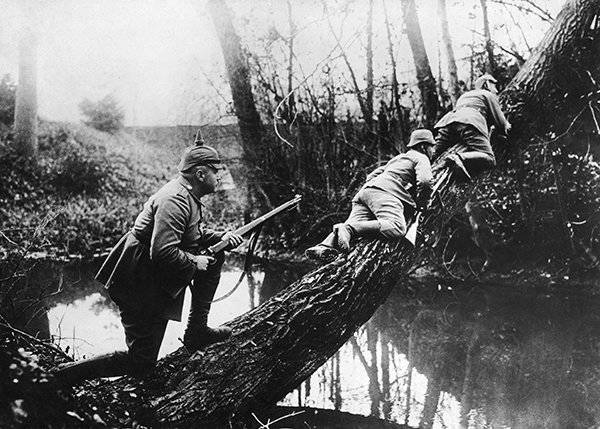
8 August 1904, the new model M.98 was followed by the German state order with a total supply of thousands of rifles to the 500. According to V. Khristich, a high-level state support, Paul Mauser turned his production into an exemplary weapon concern. The production program for the production of rifles “Mauser M.98” was provided by 3 to thousands of workers and employees, 2 thousands of machines, 7 state-of-the-art steam engines for those times, 2 hydro turbine power stations, several powerful locomotives.
Apogee and death of the great Mauser
The rearmament of the huge German army with the Model M.NUMX rifle provided Mauser and its permanent subcontractor “DWM” (the successor of “Ludwig Leve and Co.”) full load for many years until the end of the Great War. In cooperation with the DWM ammunition factories, Paul Mauser switched to a new standard of a unguided 98-mm cartridge for his rifle — the so-called “S” series, equipped with smokeless powder and a pointed bullet.
The new structure of gunpowder allowed to increase the total charge in the cartridge (without changing the shape and volume of the liner), to increase the pressure in the barrel to 3200 atm. and the initial speed of the light bullet is up to 875 m / s. As a result, the range of a direct shot at the waist figure of a Mauser M.98 rifle increased from 305 to 413 meters, at the same time the flatness, penetrability and accuracy of the shot were increased at all distances.
Public recognition of Paul Mauser’s merits in strengthening Germany’s defense capabilities received a political equivalent in 1898: he became a member of the Reichstag, and 14 in June 1902, the city of Ouerndorf, declared him an honorary citizen.
Surrounded by numerous households and associates in the arms shop, the genius of the German arms industry died in Oberndorf on May 29 of 1914. Mourning for Paul Mauser was posted on the buildings of all well-known weapons companies in the world.
The position of the arms empire of Paul Mauser, despite his demise, was unshakable until the end of the First World War. A new order in the spring of 1915 of the year for 800 thousand rifles increased the authorized capital of the firm "Mauser" from 2 to 10 million Reichsmarks. The huge volume of military orders forced the management of the company to completely stop the production of civilian weapons. Up to 1918, the firm Mauser mainly worked on the production of M.98 rifles, an automatic pistol of the same name and military ammunition.
In 1998, Mauser held a series of events in Germany dedicated to the centenary of the famous rifle, and among other things was presented a special edition of M. 98 in the number of 1998 pieces that fully matched the design of the first batch of military order 1904 of the year. Each rifle of the anniversary series is numbered, ranging from the 19980001 number to 19981998, and is provided with a special gift certificate.
The total number of military rifles of Paul Mauser with a “chess” arrangement of cartridges in the store (models from M.93 to M.98), produced by factories of different states, cannot be accurately determined. According to various experts, the true number may be in the range from 10 to 20 million pieces. This unprecedented fact alone allows us to assign the honorary title “wolkgun” - a people's gun to the gun brainchild of Paul Mauser.
Information